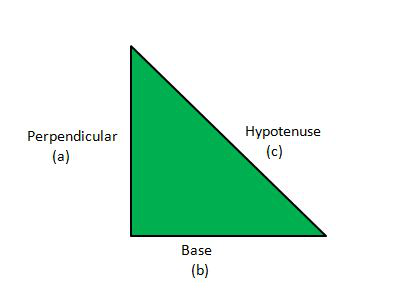勾股定理公式
勾股定理也称为毕达哥拉斯定理,可以定义为直角三角形的三个边(斜边、底边、垂边)之间的关系。它指出两个小边(底边和垂直边)的平方和等于最长边(斜边)的平方。
这个定理以出生于公元前 570 年左右的希腊哲学家毕达哥拉斯命名。

勾股定理公式
a2 + b2 = c2
Here c is denoting the length of the hypotenuse and a and b are denoting the lengths of the perpendicular and the base.
Therefore,
Hypotenuse2 = Perpendicular2 + Base2
示例:取一个边数为 3、4、5 的直角三角形,现在证明勾股定理。
解决方案:
Sum of squares of two small sides = 32 + 42 = 25
Square of the longest side = 52 = 25
Hence we can see that
sum of squares of two small sides = square of the longest side
25 = 25
勾股定理显示了直角三角形边的关系,因此如果缺少任何边的长度,可以使用勾股定理计算。
如果a(Perpendicular)和b(Base)的长度都给定了,那么c的长度可以使用以下公式计算:
c = √(a2 + b2)
Similarly a and b can also be calculated if those are missing.
示例问题
问题 1:求底边为 6 厘米,高为 8 厘米的直角三角形的斜边?
回答:
Using Pythagorean theorem, a2 + b2 = c2
So 62 + 82 = c2
hence c = √(36 + 64)
c = √100
c = 10 cm
问题2:找出给定的三角形是否是直角三角形,边是6、8、12?
回答:
A right-angled triangle follows the Pythagorean theorem so let’s check it.
Sum of squares of two small sides should be equal to the square of the longest side
So 62 + 82 must be equal to 122
but 36 + 64 =100 while 122 = 144
Hence it is not a right angled triangle as it is not satisfying the Pythagorean theorem.
问题 3:求一个直角三角形的底边,它的斜边是 13 厘米,高是 12 厘米?
回答:
Using Pythagorean theorem, a2 + b2 = c2
a(perpendicular)= 12, c(hypotenuse) = 13, find b(base)
So b = √(c2 – a2)
hence b = √(169 – 144)
b = √25
b = 5 cm
问题 4:求斜边为 25 厘米,底边为 7 厘米的直角三角形的垂线?
回答:
Using Pythagorean theorem, a2 + b2 = c2
b(base)= 7, c(hypotenuse) = 25, find a(perpendicular)
so a = √(c2 – b2)
hence a = √(625 – 49)
a = √576
a = 24 cm
问题5:找出给定的三角形是否是直角三角形,边是10、24、26?
回答:
A right-angled triangle follows the Pythagorean theorem so let’s check it.
Sum of squares of two small sides should be equal to the square of the longest side
so 102 + 242 must be equal to 262
100 + 576 = 676 which is equal to 262 = 676
Hence the given triangle is a right-angled triangle because it is satisfying the Pythagorean theorem.